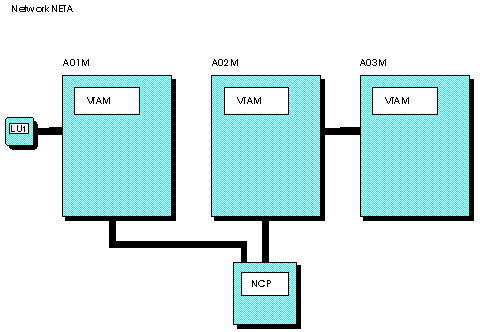 z/OS Communications Server: SNA Network Implementation Guide
z/OS Communications Server: SNA Network Implementation Guide
 z/OS Communications Server: SNA Network Implementation Guide
z/OS Communications Server: SNA Network Implementation Guide
|
Previous topic |
Next topic |
Contents |
Contact z/OS |
Library |
PDF
Static definition of adjacent SSCPs z/OS Communications Server: SNA Network Implementation Guide SC27-3672-01 |
|
|
Following is an example of an adjacent SSCP table. This
table is coded in host A01M, whose configuration is illustrated in Figure 1.
The cdrmname used on the adjacent CDRM definition
statement in the adjacent SSCP table must be the same as:
Figure 1. Example of adjacent
SSCP table connection
 In the SSCP of the originating logical unit, the CDRM name of the destination logical unit, if known, must be correct. If the CDRM name of the destination LU is not correct, the operator must issue a MODIFY CDRM command to change the CDRM name. If SSCPORD=DEFINED and network specific tables have been coded, session requests for DLU resources are not guaranteed to succeed unless at least one entry in the network specific table provides a connection to the DLU. During adjacent SSCP routing for the DLU resource, SSCP entries are taken from either the network specific table or the default table. If the NETID of the DLU resource is known and a network specific table is coded for that NETID, that table will be used. Otherwise, entries from the default table will be used when the NETID is not known. It is possible to code an entry in the default table that has a connection to the DLU and not code an equivalent entry in the DLU network specific table. If SSCPORD has the value of DEFINED, a session request for an unknown DLU would be successful because of the working entry in the default table. Subsequent session requests will now use the network specific table because the DLU NETID is known. If the network specific table (matching the NETID of the DLU) does not contain entries which provide a connection to the DLU, the routing for these subsequent sessions will fail. 


|
 Copyright IBM Corporation 1990, 2014 Copyright IBM Corporation 1990, 2014 |